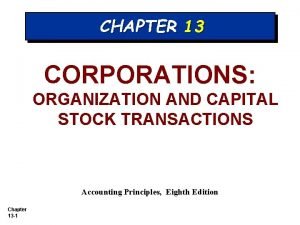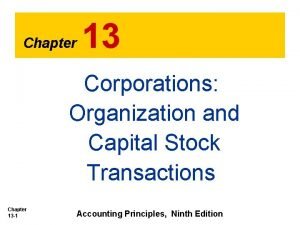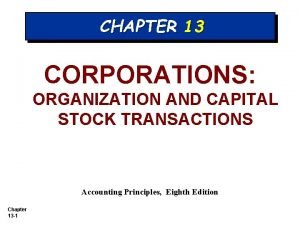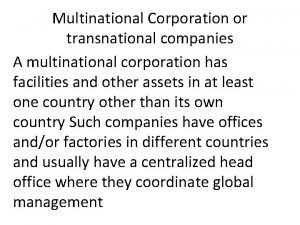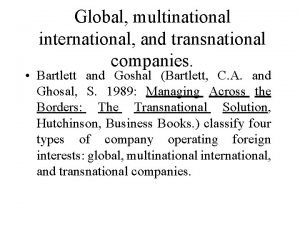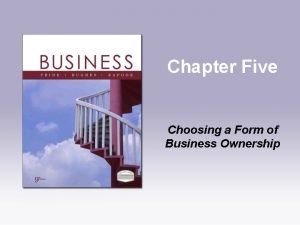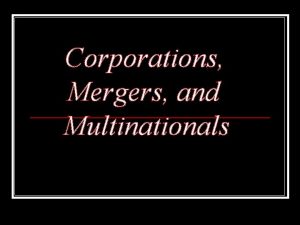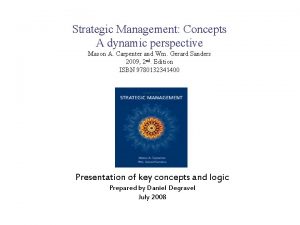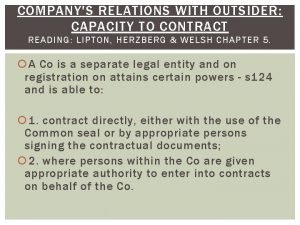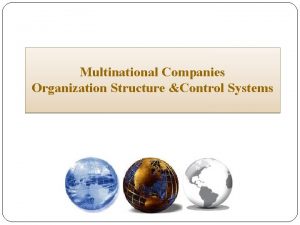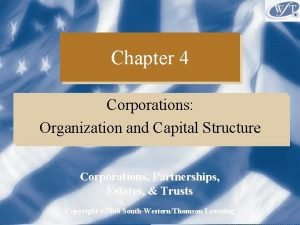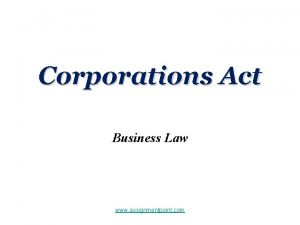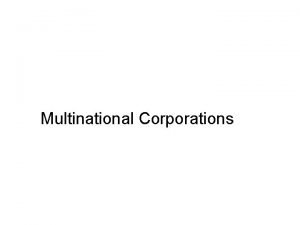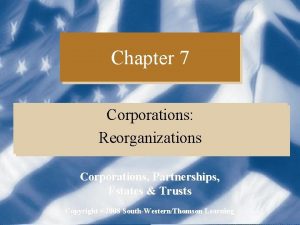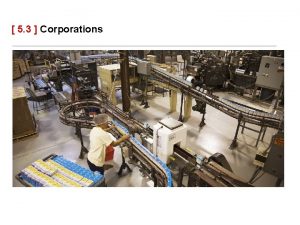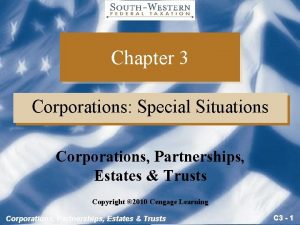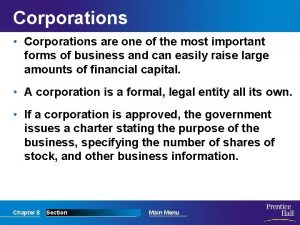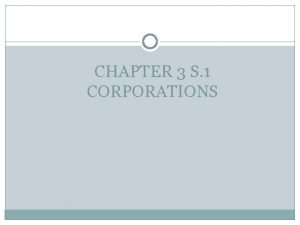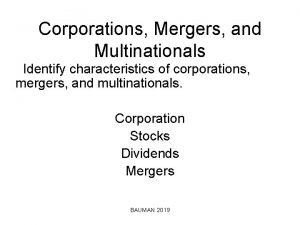Financial Accounting Module 13 Accounting for Corporations Module

































- Slides: 33

Financial Accounting Module 13: Accounting for Corporations

Module Learning Outcomes Describe the accounting and reporting concepts unique to corporations 13. 1: Describe the corporate form of doing business 13. 2: Account for issuance of Stock 13. 3: Account for distributions to shareholders 13. 4: Illustrate financial statement presentation of stockholder's equity

Corporations

Learning Outcomes: Corporations 13. 1: Describe the corporate form of doing business 13. 1. 1: Describe the basic steps in forming a corporation 13. 1. 2: Identify the defining characteristics of a corporation 13. 1. 3: Identify different types of corporations 13. 1. 4: Recognize the benefits and drawback of the corporate form of doing business

Describe the Basic Steps in Forming a Corporations are chartered by the state. Each state has a corporation act that permits the formation of corporations by qualified persons. Incorporators are persons seeking to bring a corporation into existence. Most state corporation laws require a minimum of three incorporators, each of whom must be of legal age, and a majority of whom must be citizens of the United States. After supplying the information requested in the incorporation application form, incorporators file the articles with the proper office in the state of incorporation. Each state requires different information in the articles of incorporation, but most states ask for the following: ● Name of corporation. ● Location of principal offices. ● Purposes of business.

Describe the Basic Steps in Forming a Corporation (cont’d) Each state requires different information in the articles of incorporation, but most states ask for the following: (cont’d list) ● Number of shares of stock authorized, class or classes of shares, and voting and dividend rights of each class of shares. ● Value of assets paid in by the incorporators (the stockholders who organize the corporation). ● Limitations on authority of the management and owners of the corporation. ● On approving the articles, the state office (frequently the secretary of state’s office) grants the charter and creates the corporation. As soon as the corporation obtains the charter, it is authorized to operate its business. The incorporators call the first meeting of the stockholders. Two of the purposes of this meeting are to elect a board of directors and to adopt the bylaws of the corporation.

Identify the Defining Characteristics of a Corporations have a number of distinguishing characteristics. The most significant of these are: ● ● ● ● Separate Legal Existence Continuous Life Ability to Acquire Capital Transferability Limited Liability Government Regulations Taxation Governance and Management

Identify Different Types of Corporations For Profit v. Not-For-Profit A corporation may be organized for the purpose of making a profit, or it may be not-for-profit. Forprofit corporations include such well-known companies as Mc. Donald’s, Nike, Pepsi. Co, and Facebook. Not-for-profit corporations are organized for charitable, medical, or educational purposes. Examples are the Salvation Army and the American Cancer Society Publicly-held v. Privately-held Classification by ownership differentiates publicly held and privately held corporations. A publicly held corporation may have thousands of stockholders, such as IBM, Caterpillar, and Apple. When the stock is first issued, the corporation receives the proceeds, but subsequent trading is between individuals and institutions on a national securities exchange such as the New York Stock Exchange or NASDAQ. In contrast, a privately held corporation usually has only a few stockholders, and does not offer its stock for sale to the general public. Privately held companies are generally much smaller than publicly held companies, although some notable exceptions exist.

Recognize the Benefits and Drawbacks of the Corporate Form of Doing Business

Recognize the Benefits and Drawbacks of the Corporate Form of Doing Business Form of business Sole Proprietorship Advantages Disadvantages Easy and inexpensive to create Unlimited liability, meaning business debts are personal debts Flexibility and control to your liking Limited internal expertise Few Government regulations Limited access to financial capital Tax advantages if struggling Not separate from owners lifespan Profits taxed once Easy to organize Access to combined knowledge, skills and Partnerships (General/ resources Limited Partnerships) Few Government regulations Profits taxed once at the partner level Unlimited liability for general partners Possible conflict development between partners Profits must be split between partners

Recognize the Benefits and Drawbacks of the Corporate Form of Doing Business (cont. ) Form of Business Corporation Advantages Disadvantages Limited liability Double taxation Virtually unlimited access to equity and debt financing = Subject to extensive government ability to generate vast profits regulations, especially publicly traded corps Easy to transfer ownership (publicly traded) Complex to organize and maintain Legal entity separate from owners with continuous life Limited Liability Company Simple to organize and operate Possible conflict development between members Flexible in nature Profits must be split between members Can elect to be taxed as a partnership (or sole proprietor if single-member LLC) Legal entity separate from owners with continuous life Limited liability for owners S Corporation Greater credibility for financing Taxed like a partnership Not as regulated as publicly traded corporation Legal entity separate from owners with continuous life Restrictions on number and type of shareholders

Capital Stock Transactions

Learning Outcomes: Capital Stock Transactions 13. 2: Account for issuance of Stock 13. 2. 1: Account for the issuance of stock 13. 2. 2: Distinguish between characteristics of common and preferred stock 13. 2. 3: Account for buying and selling shares of treasury stock

Account for the Issuance of Stock Shares authorized is the number of shares a corporation is allowed to issue (sell). For a large corporation this is based on a decision by its Board of Directors, a group elected to represent and serve the interest of the stockholders. Authorization is just permission to sell shares of stock; no action has actually taken place yet. Therefore, there is no journal entry for a stock authorization. Shares issued is the number of shares a corporation has sold to stockholders for the first time. The number of shares issued cannot exceed the number of shares authorized. JOURNAL Date Description Post. Ref. Debit Credit 20– Oct. 1 Checking Common Stock To record issuance of 15, 000 shares of $10 par stock at $10 per share 150, 000. 00

Distinguish Between Characteristics of Common and Preferred Stock There are three main differences between common stock and preferred stock. 1. Preferred shareholders have priority over a company’s income, meaning they are paid dividends before common shareholders. 2. In the event a company dissolves, preferred shareholders are paid after creditors but before common stockholders. 3. Preferred stock functions similarly to bonds since with preferred shares, investors are promised a fixed return on investment. In addition: • • Dividends Liquidation Return on Investment Convertibility

Account for Buying and Selling Shares of Treasury Stock When a business buys back its own shares, these shares become “treasury stock” and are decommissioned. In and of itself, treasury stock doesn’t have much value. These stocks do not have voting rights and do not pay any distributions. However, in certain situations, the organization may benefit from limiting outside ownership. Reacquiring stock also helps raise the share price, providing investors with an immediate reward. Journal Date Description Page XX Post. Ref. Debit Credit 20– Oct. 1 Treasury Stock Checking To record repurchase of 1, 000 shares of stock at $45 per share. 45, 000. 00

Practice Question 1 The YZX company was forced into bankruptcy as sales plummeted in 2020 and had to liquidate its assets to pay off its debts and stockholders. If you owned stock in YZX, which type of stock would it be best to own at this point? A. B. C. D. Treasury stock Common stock Preferred stock Common stock after a stock split

Distribution of Earnings

Learning Outcomes: Distribution of Earnings 13. 3: Account for distributions to shareholders 13. 3. 1: Define dividends and how they are declared and distributed 13. 3. 2: Account for the declaration and payment of dividends 13. 3. 3: Account for cumulative preferred dividends 13. 3. 4: Account for the declaration and distribution of stock dividends 13. 3. 5: Recognize the effects of a stock split on the financial statements

Define Dividends and How They Are Declared and Distributed Cash dividends are corporate earnings paid out to stockholders. They are payouts of retained earnings, which is accumulated profit. Therefore, cash dividends reduce both the Retained Earnings and Cash account balances. There are three prerequisites to paying a cash dividend: a decision by the Board of Directions, sufficient cash, and sufficient retained earnings. Four dates are associated with a cash dividend: • Declaration Dte • Ex-Dividend Date • Record Date • Payment Date

Account for the Declaration and Payment of Dividends When a dividend is declared by the board of directors, the company will credit dividends payable and debit an owner’s equity account called Dividends or perhaps Cash Dividends is a contra stockholders’ equity account that temporarily substitutes for a debit to the Retained Earnings account. Just like owner withdrawals are closed to owner’s equity in a sole proprietorship at the end of the accounting period, Cash Dividends is closed to Retained Earnings. Journal Date Description Page XX Post. Ref. Debit Credit 20 X 1 Dec 10 Cash Dividends Payable To record declaration of cash dividend of $0. 50 on common stock 12, 000 12, 000. 00

Account for Cumulative Preferred Dividends Preferred stockholders are paid a designated dollar amount per share before common stockholders receive any cash dividends. If the dividend declared is not enough to pay the entire guaranteed amount per preferred share before common stockholders. the amount declared is divided by the number of preferred shares. Common stockholders would then receive no dividend payment.

Account for Cumulative Preferred Dividends

Account for the Declaration and Distribution of Stock Dividends Corporate earnings distributed to stockholders from retained earnings, which is accumulated profit. Stockholders receive additional shares of stock instead of cash. They transfer value from Retained Earnings to the Common Stock and Paid-in Capital in Excess of Par – Common Stock accounts, which increases total paidin capital. The total value of equity remains the same from both the investor’s perspective and the company’s perspective. All stock dividends require a journal entry for the company issuing the dividend. This entry transfers the value of the issued stock from the retained earnings account to the paid-in capital account. The amount transferred between the two accounts depends on whether the dividend is a small stock dividend or a large stock dividend. ● ● A stock dividend is considered small if the shares issued are less than 25% of the total value of shares outstanding before the dividend. A journal entry for a small stock dividend transfers the market value of the issued shares from retained earnings to paid-in capital. Large stock dividends are those in which the new shares issued are more than 25% of the value of the total shares outstanding prior to the dividend. In this case, the journal entry transfers the par value of the issued shares from retained earnings to paid-in capital.

Recognize the Effects of a Stock Split on the Financial Statements Stock Split When a corporation reduces the par value of each share of stock outstanding and issues a proportionate number of additional shares. • It may affect the par value and market price per share, reducing them proportionately. • The total dollar value of the shares outstanding does not change. • No journal entry is required for a stock split.

Financial Statement Presentation

Learning Outcomes: Financial Statement Presentation 13. 4: Illustrate financial statement presentation of stockholders’ equity 13. 4. 1: Illustrate the balance sheet presentation of stockholders’ equity 13. 4. 2: Recognize the components of stockholders’ equity

Illustrate the Balance Sheet Presentation of Stockholders’ Equity Sole Proprietorship Capital contributions Net income less owner withdrawals Corporation Common stock, at par Paid-in capital Retained earnings Accumulated other comprehensive gain/loss Treasury stock

Illustrate the Balance Sheet Presentation of Stockholders’ Equity

Recognize the Components of Stockholders’ Equity Any change in the Common Stock, Retained Earnings, or Dividends accounts affects total stockholders’ equity and those changes are shown on the statement of stockholders’ equity. Stockholders’ Equity can increase in two ways: 1. Stock is issued and Common Stock increases, and/or 2. Business makes a profit and Retained Earnings increases. Stockholders’ Equity can decrease in two ways: 1. Dividends are distributed and Retained Earnings decreases, and/or 2. Business takes a loss and Retained Earnings decreases.

Practice Question 2 Grace is a new accountant for the FGH, Inc. and is compiling its Balance Sheet for the end of the year. Which of these accounts should Grace represent as Stockholders’ Equity on the Balance Sheet? A. B. C. D. Stock Dividends Owner’s Equity Cash Dividends Retained Earnings

Quick Review • What are the basic steps in forming a corporation? • What are the defining characteristics of a corporation? • How many different types of corporations are there and what are they? • What are the benefits and drawback of the corporate form of doing business? • What is the process for the issuance of stock? • How are common and preferred stock similar and different? • How are shares of treasury stock bought and sold?

More Quick Review • What are dividends and how are they declared and distributed? • What is the process for the declaration and payment of dividends? • How are cumulative preferred dividends factored? • What process is followed for the declaration and distribution of stock dividends? • What are the effects of a stock split on the financial statements? • How is stockholders’ equity presented on the balance sheet? • What are the components of stockholders’ equity?
 Characteristics of corporation
Characteristics of corporation Corporate capital
Corporate capital Accounting for corporations chapter 13
Accounting for corporations chapter 13 Intermediate accounting chapter 1
Intermediate accounting chapter 1 Investment center
Investment center Multinational vs transnational
Multinational vs transnational Multinational vs transnational corporations
Multinational vs transnational corporations Learnnowbiz
Learnnowbiz Disadvantages of corporations
Disadvantages of corporations Corporations mergers and multinationals
Corporations mergers and multinationals Mnc company definition
Mnc company definition Strategic management a dynamic perspective
Strategic management a dynamic perspective Types of corporations
Types of corporations Crabtree-vickers v australian direct mail
Crabtree-vickers v australian direct mail How to control multinational corporations
How to control multinational corporations Chapter 6 corporations act
Chapter 6 corporations act Nestle company organizational structure
Nestle company organizational structure Objectives of multinational corporations
Objectives of multinational corporations Corporations developed rapidly in the 1830s
Corporations developed rapidly in the 1830s Characteristics of corporation
Characteristics of corporation Kontinuitetshantering
Kontinuitetshantering Typiska novell drag
Typiska novell drag Tack för att ni lyssnade bild
Tack för att ni lyssnade bild Returpilarna
Returpilarna Shingelfrisyren
Shingelfrisyren En lathund för arbete med kontinuitetshantering
En lathund för arbete med kontinuitetshantering Kassaregister ideell förening
Kassaregister ideell förening Tidböcker
Tidböcker A gastrica
A gastrica Densitet vatten
Densitet vatten Datorkunskap för nybörjare
Datorkunskap för nybörjare Boverket ka
Boverket ka Debattartikel mall
Debattartikel mall Magnetsjukhus
Magnetsjukhus
